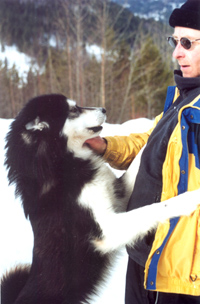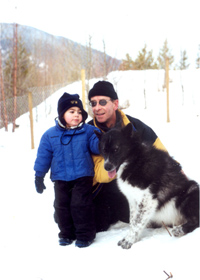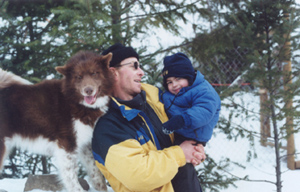Table of Contents
*
Featured Inuit Dog Owner: Merv Ehrich
*
Jubilee Medal Awarded to ISDI Co-Founder
*
Blue Eyes in Norwegian Greenland Dogs
*
ISD Enthusiasts Speak out on Blues Eyes
*
ISDI's Official Stand on Blue Eyes
*
Mountie, Alouette and Moose
*
Following Nanuk's Tracks
*
The Qitdlarssuaq Chronicles, Part 1
*
News Briefs:
New ISDI Scandinavia Web Site
Atanarjuat Update
Dog Teams in Iqaluit
Grammar Lesson
ISDs in Museum Exhibit
*
Poem: Lost Travellers
*
Book Review: first Nations.... first Dogs
*
ISD Enthusiast's First Novel Published
*
IMHO: Seeking to Answer the Wrong Question
Navigating This
Site
Index of articles by subject
Index
of back issues by volume number
Search The
Fan Hitch
Articles
to download and print
Ordering
Ken MacRury's Thesis
Our
comprehensive list of resources
Talk
to The
Fan Hitch
The Fan
Hitch home page
ISDI
home page
Editor: Sue Hamilton
Webmaster: Mark Hamilton
Contents of The Fan Hitch Website and its publications are protected by international copyright laws. No photo, drawing or text may be reproduced in any form without written consent. Webmasters please note: written consent is necessary before linking this site to yours! Please forward requests to Sue Hamilton, 55 Town Line Rd., Harwinton, Connecticut 06791, USA or mail@thefanhitch.org

Merv and his boss dog
Takoolik
Ehrich photo
Merv Ehrich
Heffley Creek, British Columbia, Canada
I have been involved with Inuit Sled Dogs since 1999. I obtained my first ISD from Jeff Dinsdale of Quesnel, British Columbia, Canada. A year later, the second dog arrived from Toadhall Inuit Sled Dog Interpretive Centre, in Manitoba.
I own no other breed of dog. My two foundation dogs were bred and I now have two males and four females. Ikkuma (from Toadhall) had a litter of four females and two males. One of each female and male went to Claude Morin in Alberta.
In the morning during the spring, summer and fall, when it's cool enough, I cyclejor with the dogs. If it's too warm, the dogs run free, one at a time, and I walk on a trail on the property. Winter of course is for sledding. For the past two winters, I only had two dogs. They had no trouble pulling me, but we live in the mountains, so I do a lot of pedaling and running on steep inclines. I look forward to running all six dogs this winter. The pups will be one and a half years old. I also plan to do dogsledding tours with the help of an additional team of ISDs from a friend nearby.
For harnesses, I use X-back and H-back. I think this winter I will use only H-backs as the weight seems to be more evenly distributed over the chest area and puts less pressure on the hips. I don't know for sure if this is so, but I guess it's all part of learning as I'm still very new to sled dogs.
My sled is a toboggan made by Irwin Wiens of Hundred-Mile House, in B.C. The bed of the toboggan is raised five inches above the runners. It's good in deeper snow conditions and on packed trails.
My dogs live in two 50 x 50 ft pens. Two females and one male in each. Each dog has its own dog house. At night, the boss dog goes with the young male and two females which have been outcast by the other females. All six dogs used to live together until the alpha female sided with a female that I call “The Chosen One”. These two females then picked on the other two young females and chewed them up to the point when separation became necessary. Now I know why I was told I had too many females. Another lesson learned!

Merv with grandson Devon and
Taika Ehrich
photo
I feed a raw meat and rice diet. I have tried some expensive commercial dog foods, but nothing compares in quality - and in the long run in price - to meat and rice. I have found a meat cutter in town who will mix liver, heart and muscle meat and then package it for me. Lately I was lucky. I was given a cow, and a few months later the butcher bought and prepared another cow for me. Getting meat that way is more economical than purchasing it in town. To the meat and rice mixture, I add Canola oil and powdered milk. After the dogs eat, they each get half a human grade multivitamin/mineral tablet. They also get 10mg of zinc daily and 200 IU of vitamin E every third day. A friend of mine thinks I'm crazy adding the vitamins and minerals, but zinc is very important for hormone balance in the ISD. That same friend lost an ISD this past winter with a number of complications. The premature death of that dog could have been avoided, according to the vet. It was due to hormone imbalance caused by a lack of zinc in its diet.
In the beginning, I intended to breed my ISDs just for building up my team. A recent visit with Geneviève and Michael Montcombroux changed my mind. I had been unaware that so few people were interested or in a position to breed other than for their own purposes. I think the ISD in its pure form is destined to fade away if new ISD enthusiasts are not found to continue what others have started before us. I will endeavor to promote the ISD and breed to sustain the numbers.
My friend Uli and I were invited to an all breed sled dog race to do a demo with our ISDs, in February 2002. The race organizer, a veteran sprint racer, had never seen an Inuit Sled Dog. Neither Uli nor I believe in racing, but went just to show off our dogs. They sure did attract attention. I gave a short presentation on the ISD on both race days, and made it very clear that they weren't racing dogs.
I have found owning and raising ISDs very challenging. Learning when to step in on fights, and when to let the boss do his job, raising puppies, proper nutrition, finding good meat sources, mending fences, replacing chewed up dog houses... all of it, is a full time occupation! At times, I feel like throwing in the towel, but just then, one of the dogs will come over to me as I sit in their pen and nuzzle up to me with great affection. Other times, I remember certain emotions as I rode the runners on an early morning or late at night, just my dogs and I, as one. It's a bonding and a feeling that I can't explain, but it makes owning and working with this special breed every bit as rewarding as it is challenging.
One of those rewarding moments came in mid-March, 2002. Devon, my three-year-old adopted grandson, came up to me in the kitchen and said: "Papa, I think Kayok (his eight-month-old pup) is big enough to pull me.” This was to be Devon and Kayok's maiden run. So without hesitation, I got Devon dressed, harnessed Kayok with my lead dog, and away we went. Once the pup settled down and we were moving along smoothly, I asked Devon if he was having fun. All I heard from the little guy sitting in the sled was: "Yaaaa!” The expression in his voice said it all.

Merv with Devon and
Kayok
Ehrich
photo